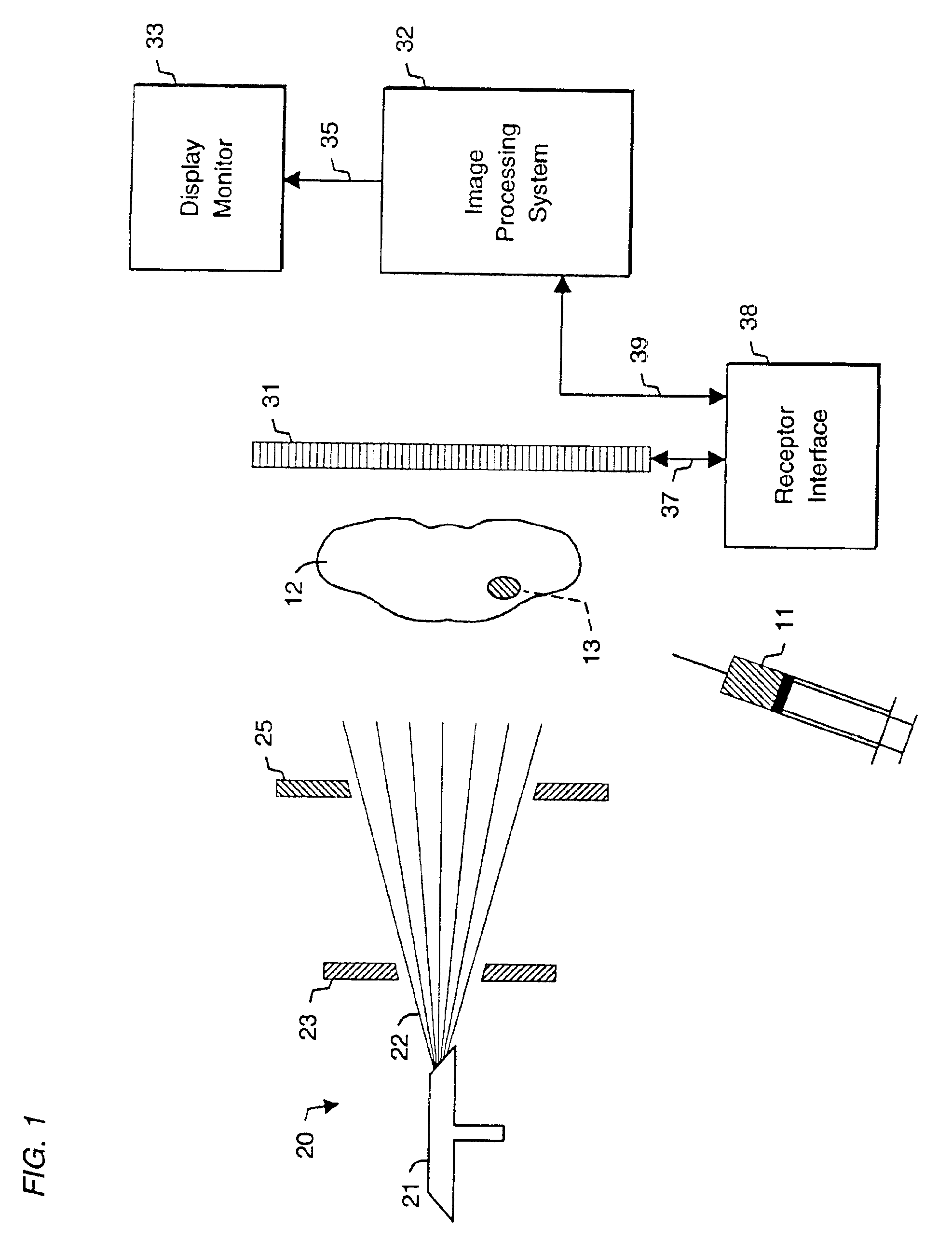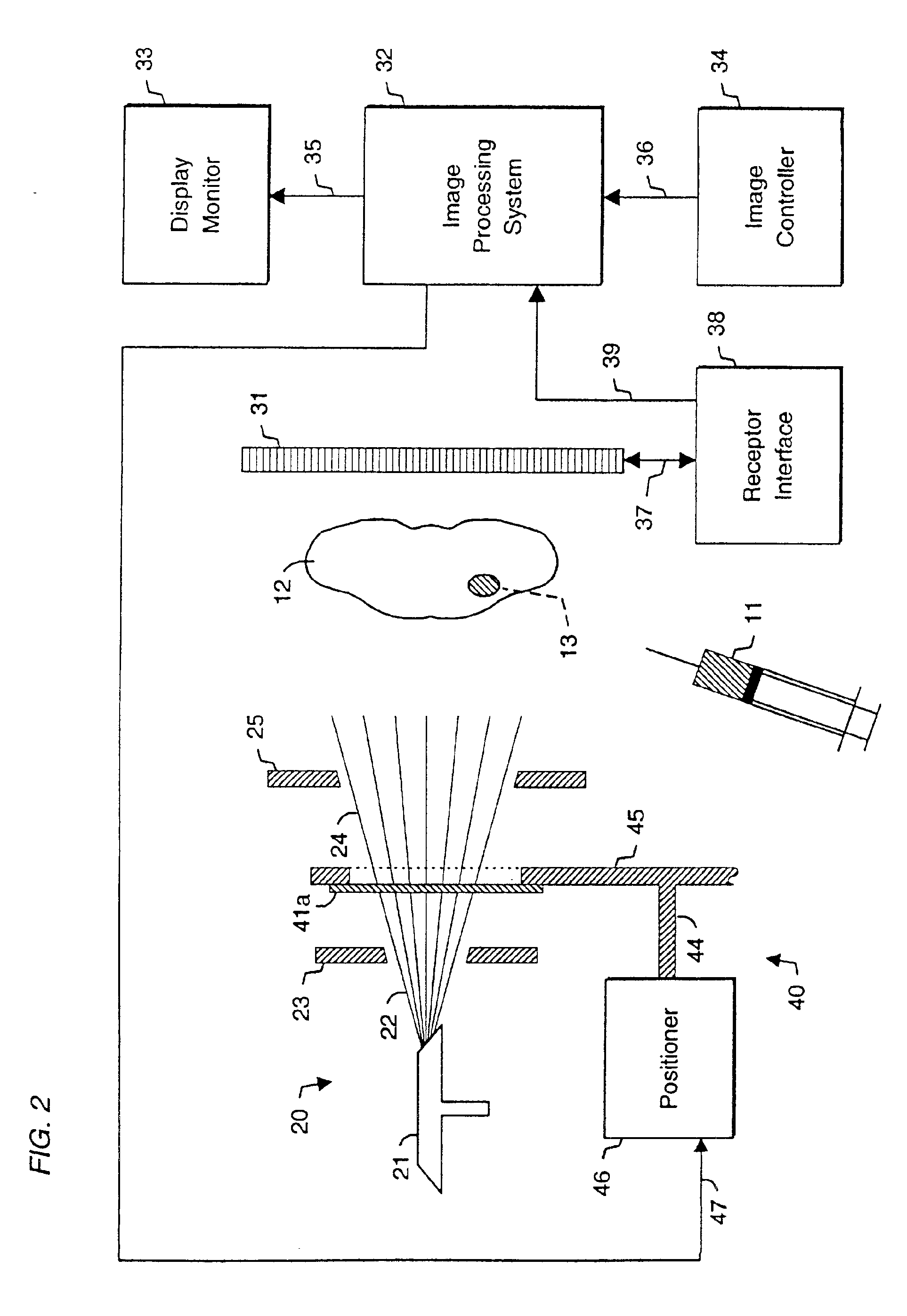System and method for radiographic imaging of tissue
a tissue radiographic imaging and tissue technology, applied in the field of medical imaging, can solve the problems of reducing the reliability of mammography as a diagnostic tool, high error rate in radiological diagnosis of cancer, and inability to visually appear tissue on the radiograph, and achieve the effect of high anatomical detail
- Summary
- Abstract
- Description
- Claims
- Application Information
AI Technical Summary
Benefits of technology
Problems solved by technology
Method used
Image
Examples
example 1
2-Amino-4-(2′,4′,6′-triiodophenyl)-benzoyl-D-glucosamine (11)
[0111]
4-iodotoluene is reacted with picryl chloride in the presence of copper bronze at 215° C. to yield 2′,4′,6′-trinitro-4-methylbiphenyl (1). C7H7I+C6H2ClN3 O6→ΔCuC13H9I3N3 O6
2′,4′,6′-trinitro-4-methylbiphenyl (1) is reacted with stannous chloride and hydrochloric acid to yield 2′,4′,6′-triamino-4-methylbiphenyl (2). C13H9N3 O6→H ClSn Cl2C13H15N3
2′,4′,6′-triamino-4-methylbiphenyl (2) is reacted with sodium nitrite and hydrochloric acid to convert the amino groups to diazonium groups. The diazonium groups react with potassium iodide to yield 2′,4′,6′-triiodo-4-methylbiphenyl (3). C13H15N3→H ClNa N O2→K I C13H9I3
Aromatic nitration of 2′,4′,6′-triiodo-4-methylbiphenyl (3) is performed with nitric acid and sulfuric acid to yield a mixture of 2′,4′,6′-triiodo-2-nitro-4-methylbiphenyl (4) and 2′,4′,6′-triiodo-3-nitro-4-methylbiphenyl (5). The products are separated using column chroma...
example 2
is similar in general structure to Example 1, with the additional presence of a short alkyl chain attached to the radio-opaque tri-iodophenyl moiety at the C-3′ position to further increase lipophilicity of the molecule and enhance cell membrane permeability. The computed logP of Example 2 is 5.31.
example 3
2-Amino-4-[3′,5′-bis(N-methylcarboxamide)-2′,4′,6′-triiodophenyl]-benzoyl-D-glucosamine (24)
[0114]
Freidel-Crafts acylation is performed on 2′,4′,6′-triiodo-3′-ethyl-3-nitrobiphenyl-4-carboxylic acid (13) in the presence of AlCl3 and CH3COCl to yield 2′,4′,6′-triiodo-3′-ethyl-5′-acetyl-3-nitrobiphenyl-4-carboxylic acid (17). 2′,4′,6′-triiodo-3′-ethyl-5′-acetyl-3-nitrobiphenyl-4-carboxylic acid (17) is then reacted with a zinc mercury amalgam and hydrochloric add and heated to yield 2′,4′,6′-triiodo-3′,5′-bis(ethyl)-3-nitrobiphenyl-4-carboxylic acid (18). C15 H10I3NO4→C H3C O ClAl Cl3→ΔZn(Hg), H ClC17 H14I3N O4
2′,4′,6′-triiodo-3′,5′-bis(ethyl)-3-nitrobiphenyl-4-carboxylic acid (18) is reacted with thionyl chloride to yield 2′,4′,6′-triiodo-3′,5′-bis(ethyl)-3-nitrobiphenyl-4-carbonyl chloride (19). C17 H14I3N O4→S O Cl2C17 H13ClI3N O3
1,3,4,6-tetra-O-acetyl-D-glucosamine (9) is reacted with 2′,4′,6′-triiodo-3′5′-bis(ethyl)-3-nitrobiphenyl-4-c...
PUM
| Property | Measurement | Unit |
|---|---|---|
| time | aaaaa | aaaaa |
| molecular weights | aaaaa | aaaaa |
| logP | aaaaa | aaaaa |
Abstract
Description
Claims
Application Information
 Login to View More
Login to View More - R&D
- Intellectual Property
- Life Sciences
- Materials
- Tech Scout
- Unparalleled Data Quality
- Higher Quality Content
- 60% Fewer Hallucinations
Browse by: Latest US Patents, China's latest patents, Technical Efficacy Thesaurus, Application Domain, Technology Topic, Popular Technical Reports.
© 2025 PatSnap. All rights reserved.Legal|Privacy policy|Modern Slavery Act Transparency Statement|Sitemap|About US| Contact US: help@patsnap.com



